Each of the 16 teams in the Euro 2022 finals has now played at least one match, with the second round of group stage matches well and truly underway. As a result, fans of each nation have had the chance to watch their players and assess whether their team can make it through to the knockout stages. Austria are one of the eight teams who have played twice, and their hopes of progressing are still alive after a win against Northern Ireland on Monday and Norway’s heavy defeat to England, and this tactical analysis will pick out one of their players, Barbara Dunst, who has proven to be irreplaceable for Irene Fuhrmann’s side so far.
The 24-year-old Eintracht Frankfurt player has been used primarily as a winger during the tournament, but what has been increasingly clear is that she is at her best when allowed to move around the pitch and affect the game in different ways. With this in mind, this scout report will look in detail at her passing, movement and positioning, providing an analysis of why each has been critical to Austria’s tactics and style of play, and why she could hold the key to defeating Norway on Friday night.
Positioning
Beginning with her positioning, the basic point to make is that Barbara Dunst likes to drift around the pitch and not remain in one fixed position, which has made her an important player for Austria both in offensive and defensive situations.

Against England and Northern Ireland, Dunst tended to stay close to the wings when her team was attacking, giving them natural width and allowing her extra time and space to control the ball when it came her way, and this was helped by both of their opponents so far defending with a narrow line. However, the other thing that came from her wide position is that she allowed the team to play long diagonal passes too, switching play quickly and exploiting the gaps left available to them, whilst she also had the ability to put pressure on the defenders and force mistakes.
Against Northern Ireland, that last point was particularly prominent, because Kenny Shiels’ side liked to pass out from the back and build their play, which invited high presses from both Norway and Austria. As a result, once goalkeeper Jacqueline Burns hesitated here and played a short pass towards Dunst, the Frankfurt player had the perfect angle to either cross the ball into the goal area or have a shot at goal herself, and she opts for the latter on this occasion.
The fact that she has netted four times for her country in 2021/2022 and registered a further seven assists proves her threat in these areas of the pitch, so any loose passes from Norway will give them problems and allow Dunst to further demonstrate her attacking qualities.
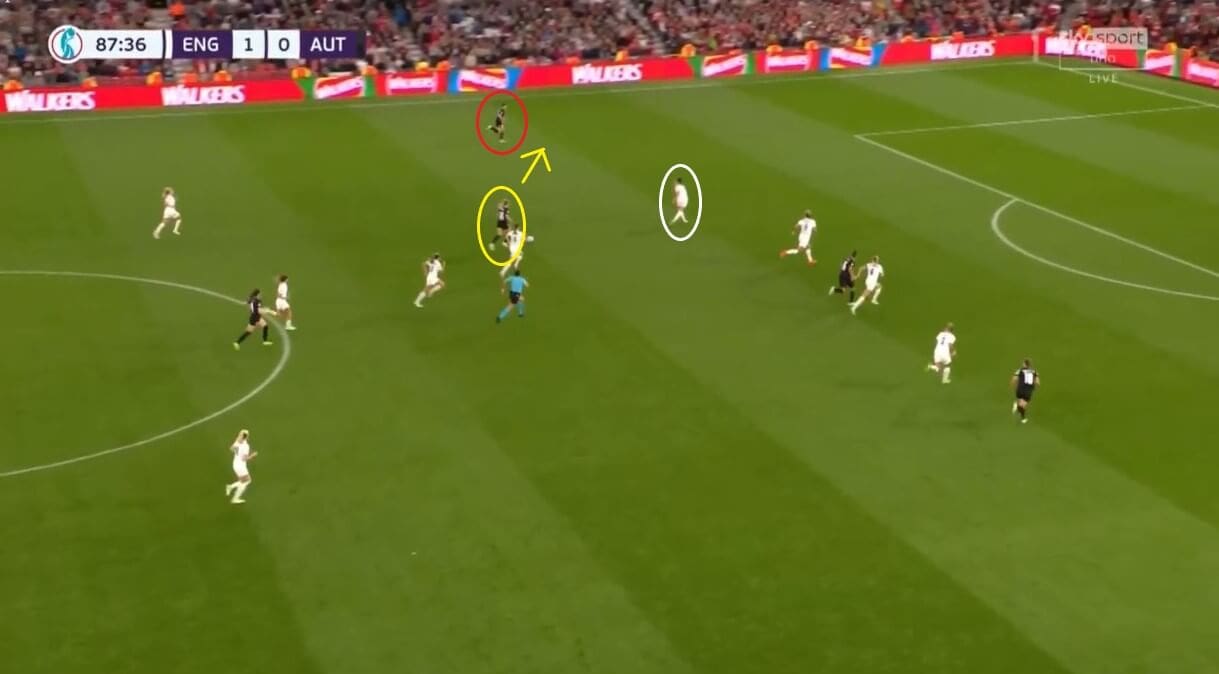
This situation reiterates the threat posed by Dunst’s wide positioning, as she has once again stayed close to the wings and waited for the ball to come to her. As mentioned, England’s defensive line is narrowly set up, with spaces left open for Austria to exploit, but the tournament hosts have been better at defending their own area than Northern Ireland have, so a cross or shot into the middle like in the last example are not good options here.
Instead, Dunst looks to drive infield and find a gap in the line that she can exploit, although her attempt is thwarted by new Barcelona Femení right-back Lucy Bronze, who reacts well and blocks her off. Nevertheless, the Austrian’s power and threat in the wide areas is once again clear to see and getting her on the ball is something that Austria have to do as often as possible.
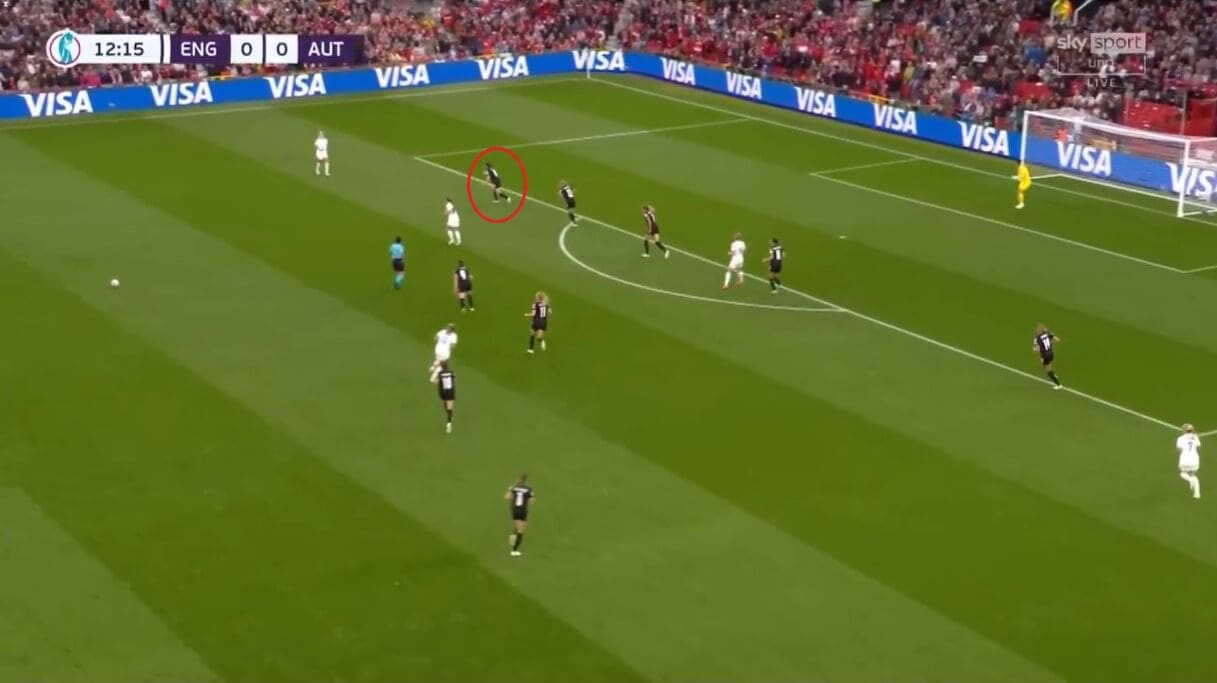
It is not only when Austria are attacking that Dunst’s positioning has proven vital. Against England, they tended to sit back more than going forwards, trying to stifle England’s much-praised attack from functioning productively, with the Lionesses generally using their wingers, Arsenal Women’s Beth Mead and Manchester City Women’s Lauren Hemp, to create space in the middle and stretch opposing defences out.
However, Dunst sees this and drops back to become a makeshift right wing-back, which spreads Austria’s defensive line out across the pitch but without leaving gaps open for England to exploit. We have stated already in this scout report that Dunst has been a key element in her team’s attack, but this shows how her awareness and positioning are just as important when they are out of possession, as she anticipates different situations and fills in where needed, always working hard for the team.
Movement
The next element of Barbara Dunst’s game is her movement around the field, which is arguably even more important than her positioning, as it means that she can disrupt opposing phases of play and give her team passing options at the right times.
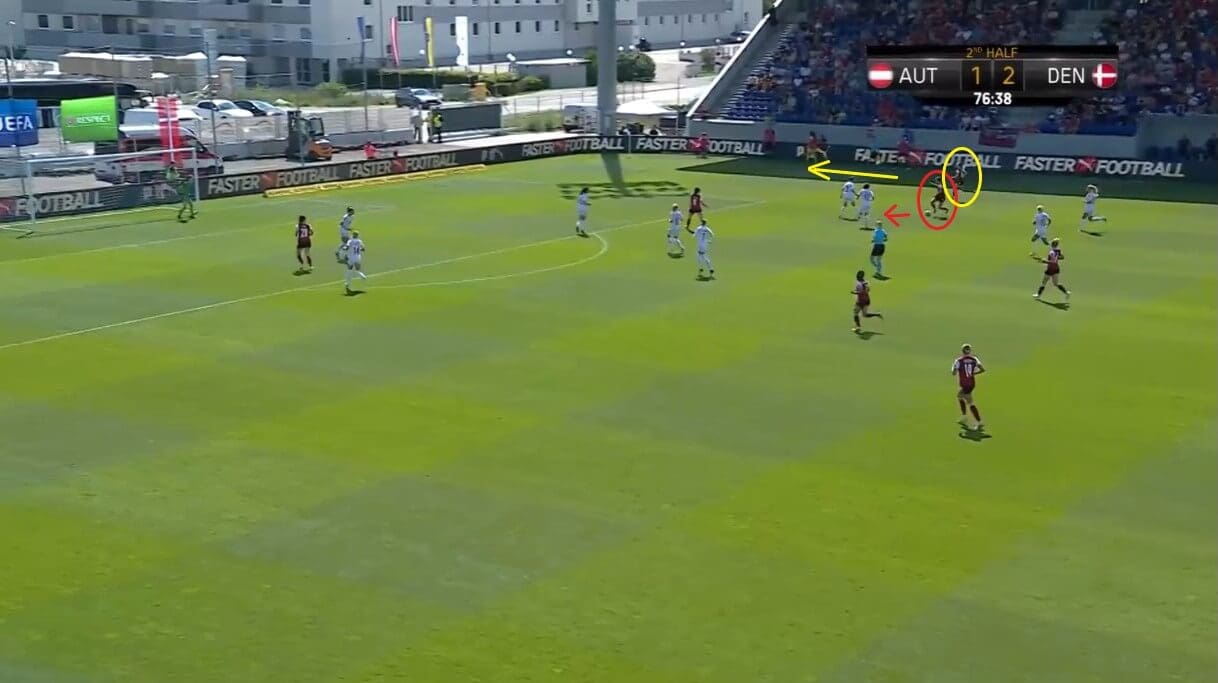
It is when playing as a winger that we see just how critical her movement can be, with this situation showing her in possession on the far side of the field. However, because Denmark play with wing-backs, they can get numbers across and block opponents from running into their box, as has happened here. Dunst knows that she can’t keep the attack going as a result, but, by taking a few steps toward the defenders ahead of her, she forces the Danish players to retreat ever so slightly and opens up a route behind for Zürich Frauen’s Marie Höbinger to use, ensuring that Austria have a way of keeping the ball moving forwards and breaking down the Danish defence.
It is these finer details of her game that make her such an interesting player to watch, with her knowledge and understanding of how she can manipulate opponents often proving vital in Austria winning tight games, and the meeting with Norway could see Dunst deploy some of these moments of brilliance as she tries to help her team secure a place in the quarter-finals.
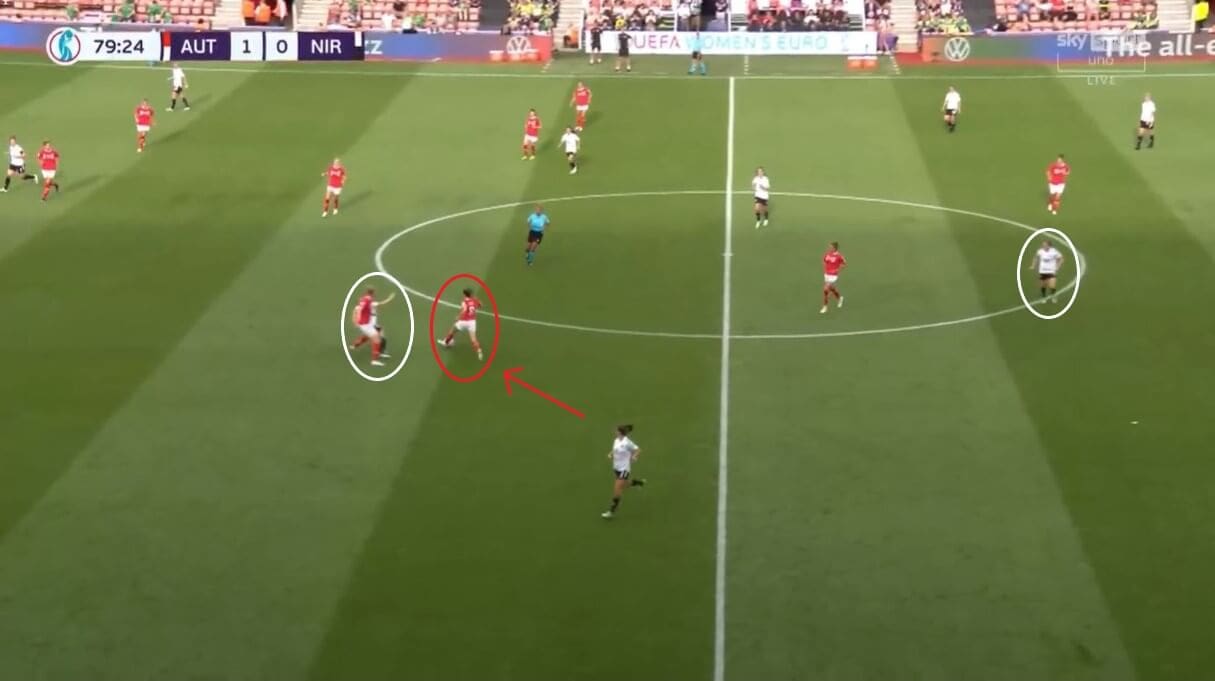
Her movement and speed around the pitch become even more important when Austria don’t have the ball, with her anticipation and ability to read the game meaning that she can move into areas without opponents realising until it is too late, as proven by her well-timed interception of the pass here from Glentoran Women midfielder Chloe McCarron to Crusaders Strikers forward Emily Wilson.
It is not a rarity that the Austrian sees and makes these quick movements to disrupt play, with her averaging 2.16 interceptions per game in 2021/2022, and it is another aspect of her play that her team have come to rely on. However, it brings us back to the point raised at the beginning of the analysis, because she is only able to move around in this way if not fixed in one position, so, whilst Austria will have a starting formation on Friday, any hopes of making it through rest on key players like Dunst being able to use their intelligence and involve themselves wherever needed.

These defensive capabilities will be just as important when the ball is further up the pitch, with Austria capable of pressing from the front when needed in order to make it as difficult as possible for Norway to construct attacks. This was easy against Northern Ireland because of their preference to play out from the back, and veteran Crusaders centre-back Julie Nelson is facing her own goal here as she controls the ball in her own box. This means that she doesn’t see Dunst moving up the field and closing her down, with the Frankfurt player’s speed again evident. Therefore, again, Dunst will be a key player when her team are defending as well as attacking, with her positioning and movement both demonstrating that point.
Passing
However, whilst both have been key to Austria causing problems for their opponents and making it difficult to play against them, it is her range of passing that has stood out as being essential to her team’s tactics so far. As will be shown throughout this section, she is capable of delivering balls with quality and accuracy and from a variety of distances, which has made her unpredictable and important in Austria’s ability to turn their possession into chances on goal.
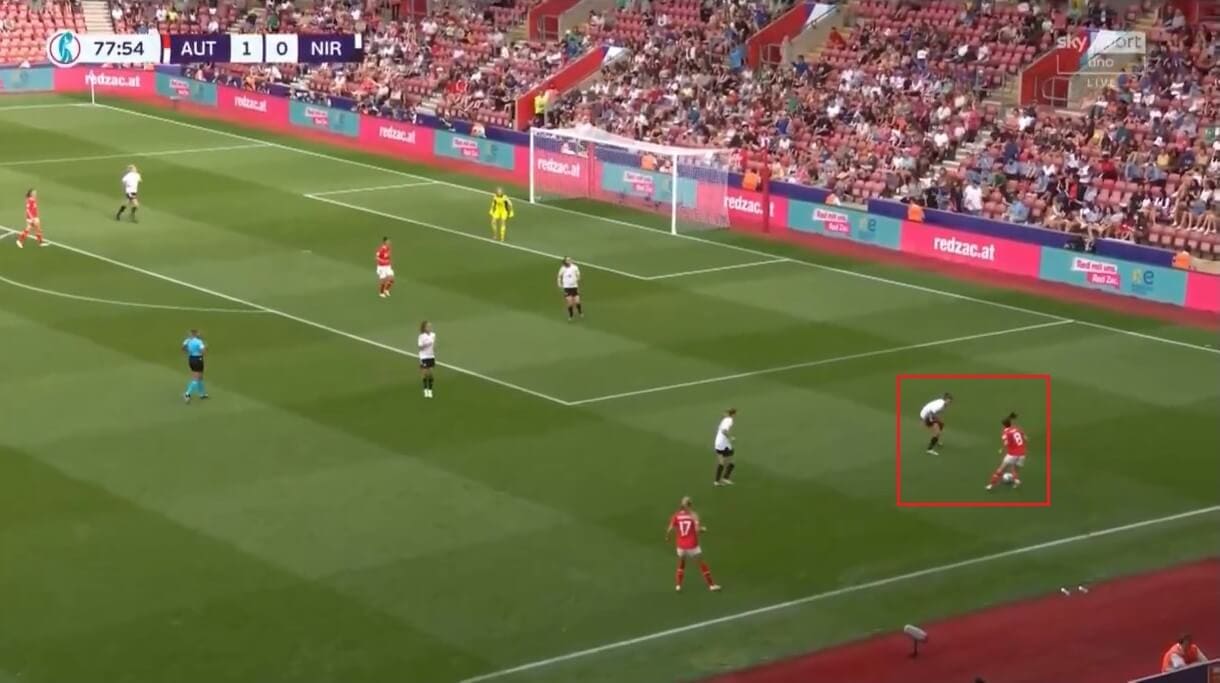
The first point to mention is that Dunst is a player who loves being in tight spaces and taking opponents on, and her sharp changes in direction, another point highlighted earlier on in the scout report, again come into play here. In this example, Northern Ireland left-back Demi Vance has come to close her down, but what the former Rangers Women player gets wrong here is that she doesn’t get tight enough to Dunst.
This allows the Austrian to again manipulate Vance’s positioning and create the angle from which she can cross the ball into the goal area, so it shows how she is a player that opponents need to limit the options of in order to starve Austria of goalscoring opportunities. Therefore, this is another thing that Norway will have to be very aware of if they are to have a chance of keeping their next opponents out.
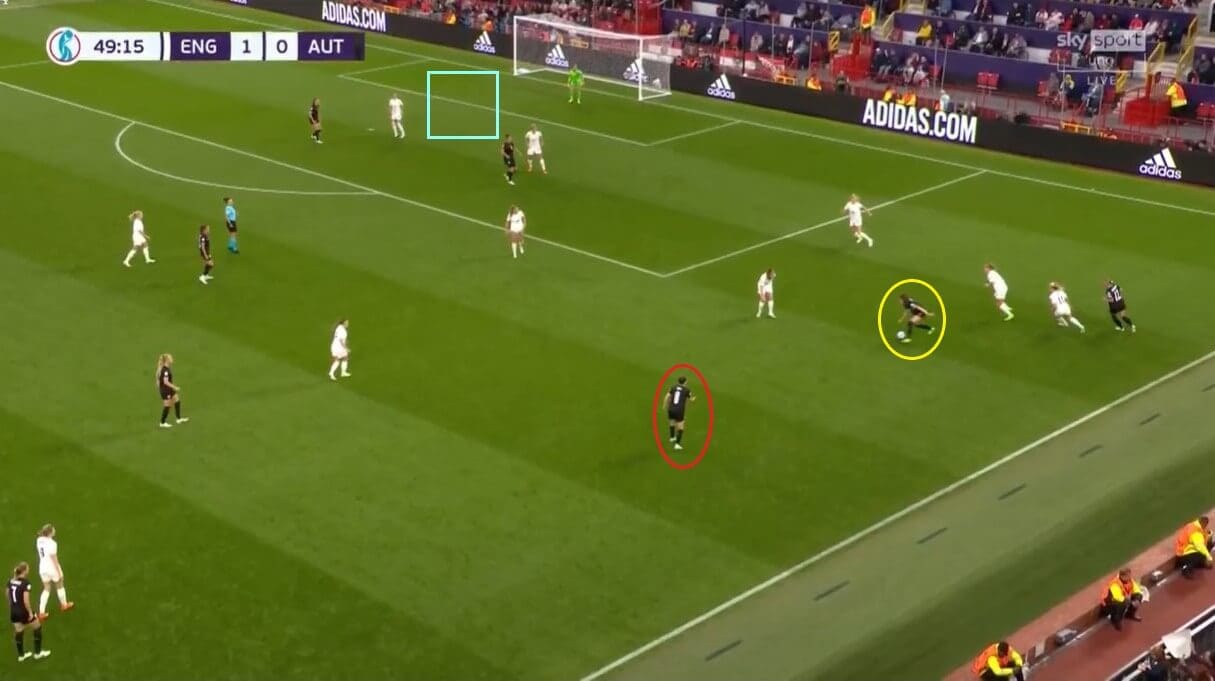
However, the Frankfurt player is just as threatening in open spaces too, with this situation showing her staying back and again waiting for the ball to come to her, as has been a key point made about her game throughout this analysis. The reason that she stays back is that she knows where she can be most useful for her side, crossing the ball in once Bayern Munich Frauen’s Sarah Zadrazil has pulled it back for her.
From Austria’s point of view, this highlights that their team communicate well and know what their different roles are, and this is why they have caught the eye and remain in contention for a place in the quarter-finals. Looking specifically at Dunst, it is clear that she is capable of operating in both small and large spaces with equal quality, indicating once again that she is a versatile player who needs to be left to play in her own way during matches. Nevertheless, it is always useful having players who can fit into different systems, especially if Austria do look to change things up on Friday night.
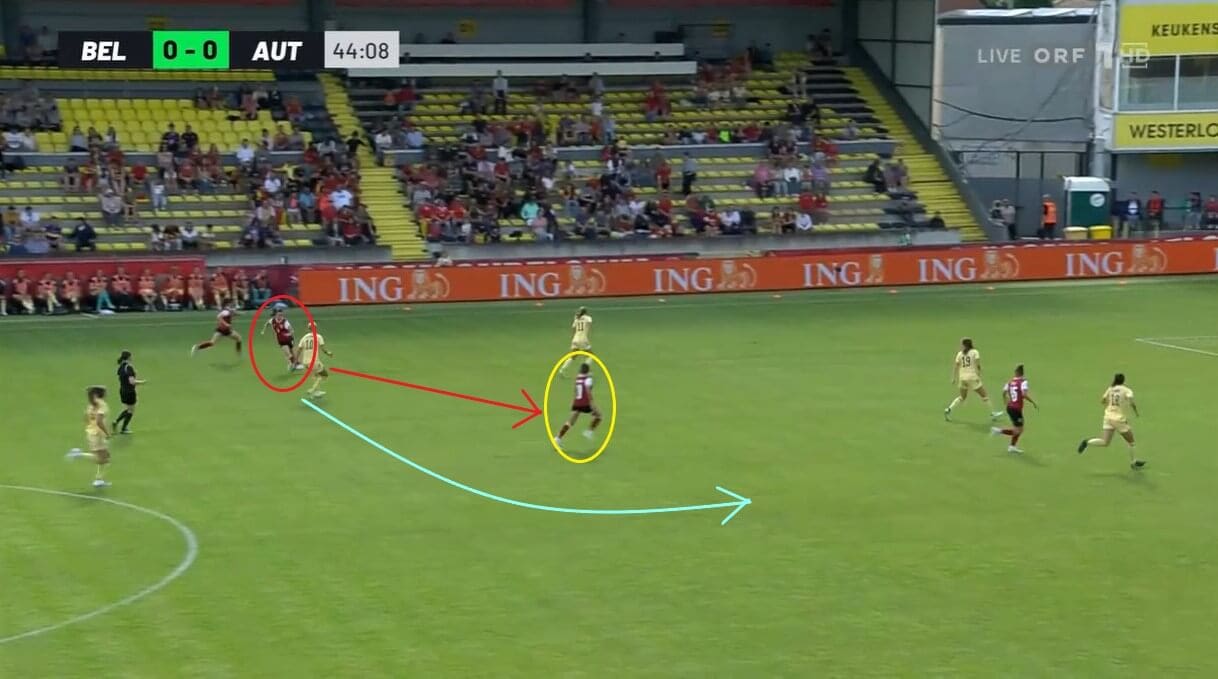
Her clever passing also comes from her awareness on the field, as she sees spaces early and is always thinking about what the next stage of the attack will be. Here, she has passed inside the pitch to left-back and Frankfurt teammate Verena Hanshaw, before then running around her teammate and into an area where she can offer the return pass option. On this occasion, Hanshaw opts to move the ball in another direction, but the intent was there from Dunst and that’s what counts.
Moves like this only work if the pass is weighted correctly, which is key, as any slight error would lose time and give Belgium a chance to come out and claim the ball from Hanshaw. However, the fact that Dunst’s average passing accuracy for her country in 2021/2022 currently stands at 71% shows that this generally hasn’t been an issue for them, and her threat is further highlighted by her 68.4% accuracy for passes to the final third, so it is clear that she does ask questions of defenders when on the ball and looking to create opportunities for her teammates.
Conclusion
In conclusion, this tactical analysis has looked at Austria’s Barbara Dunst, focusing on the 24-year-old’s importance in Irene Furhmann’s team and looking at the different qualities that will make her critical to their hopes of reaching the Euro 2022 quarter-finals. The main reason that she will be a key player is because of her ability to fit in where needed, and this does sometimes mean that she goes under the radar during matches whilst others like Nicole Billa and Zadrazil take the headlines.
Norway will undoubtedly be hurting after Monday night’s performance and are highly likely to come out fighting against Austria as they try to save their tournament. Therefore, Friday’s match will be very interesting to watch, and the way that both teams approach the contest will be even more intriguing.





Comments